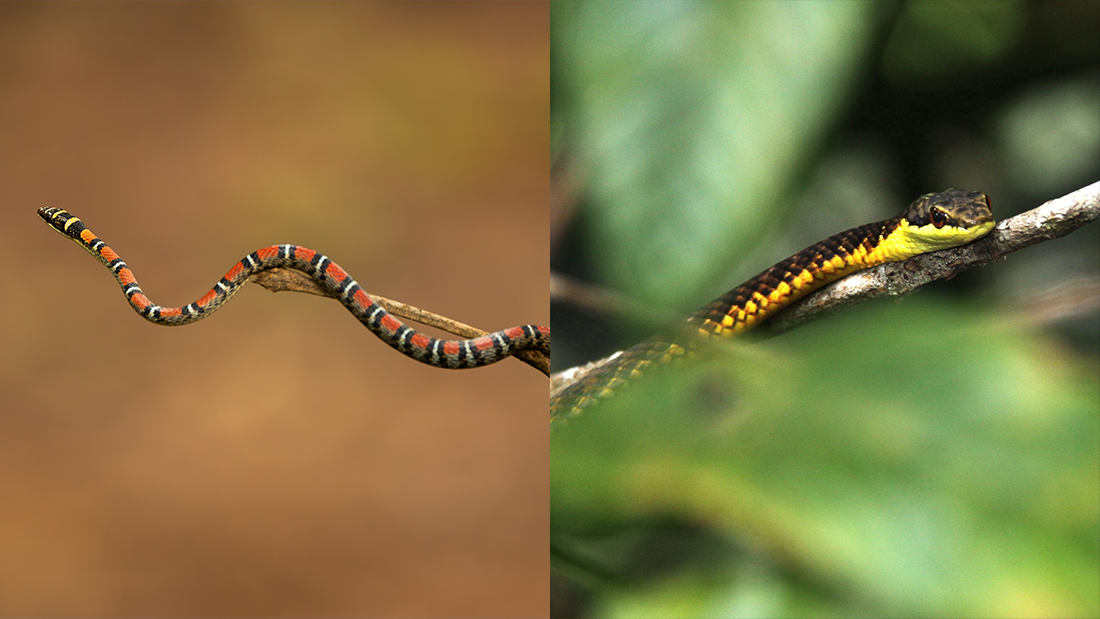When you picture something gracefully gliding through the air, your mind probably jumps to birds, bats, or maybe even flying squirrels. But we’re here to tell you, if you look up at the forest canopy in South Asia and the Indonesian archipelago, you might just see a snake take flight.
Flying snakes, of the genus Chrysopelea, consist of five species of slender, arboreal snakes belonging to the family Colubridae. They range in length from the 75-centimeter-long (2.5-foot) banded flying snake (Chrysopelea pelias) to the 120-centimeter (4-foot) Moluccan flying snake (Chrysopelea rhodopleuron) and can glide distances as far as 100 meters (300 feet) at a rate of roughly 11 meters (36 feet) per second.

The banded flying snake (left) is the smallest flying snake species, while the Moluccan flying snake (right) is the largest.
While flying snake species secrete a mild toxin, they’re all rear-fanged species, meaning the toxin-delivering teeth are at the back of their mouths rather than the front. Rear-fanged snakes produce toxins from the Duvernoy’s gland, while front-fanged species excrete true venom from the venom gland. Colubridae species are generally rear-fanged, and while there are a few deadly colubrids like the boomslang (Dispholidus typus) and tiger keelback (Rhabdophis tigrinus), the toxins from rear-fanged species, like the flying snakes, are not generally potent enough to affect humans.
The toxin delivery system for rear-fanged species requires them to chew down on prey items, aiding in the digestive process. These diurnal snakes live off a diet of rodents, lizards, birds, and bats, which they consume in the tree canopies. Being equipped with their own pilot’s license to get between trees means they have virtually no need to venture down to the forest floor, often even choosing to hatch their young high up in tree crevices.
How do flying snakes fly?
As you’ve probably guessed by now, flying snakes do not have hidden paraglider flaps like the flying dragon (Draco volans). So how do these noodles actually “fly”? Well, technically, they don’t; they just fall with style.
Flying snakes should really be called gliding snakes, as without the presence of a strong updraft, they’re not able to gain altitude in the air. Instead, they use body contortions to propel themselves and control their direction.
Before taking “flight”, these aerophiles travel to the end of a tree branch, hang off it in a J shape, and then propel off the edge using the lower half of their bodies. In a poor attempt to replicate the moves from Village People’s hit YMCA, they move from a J to an S shape in the air, while flattening their rounded bodies to produce a concave C shape by splaying their ribs. The flatness of their bodies helps to trap air as they fall, while the S-shaped positioning allows them both to stabilise their flight and control direction.
How often and exactly why these snakes take flight is still a bit of a mystery, but it’s thought to be used as a way to escape predation, as a means of travel which reduces the need to venture onto the forest floor, and maybe even as a way of catching prey.
As weird as these flying snakes might look, the tendency for unassuming arboreal species to develop the ability to “fly” is surprisingly common in Asia’s southeastern rainforests. Home to the aforementioned flying dragon, as well as a number of flying squirrel species, and even Wallace’s flying frog (Rhacophorus nigropalmatus), it’s thought that the ability developed significantly in this area because of the abundance of dipterocarp trees. These tall trees have almost entirely branchless trunks, making the journey up and down from the canopy particularly tricky for flightless suckers.
While these lanky reptiles may not be “flying” by the classical definition, they’re pretty great at what they do – they’ve even been inspiring robotics. Their populations are also thriving, with all five of them listed as Least Concern by the IUCN. So, next time you’re in Asia’s southeastern rainforests, that thing in the sky could be a bird, a plane, or even a snake.
Source Link: Yes, Flying Snakes Do Exist – Sort Of